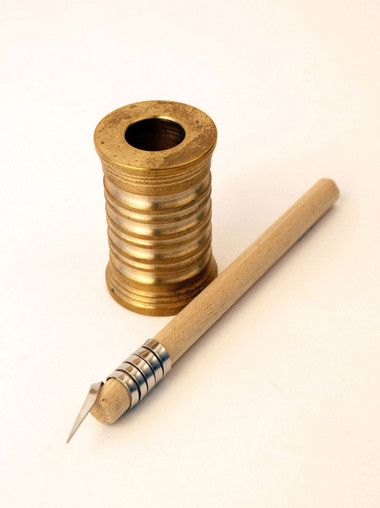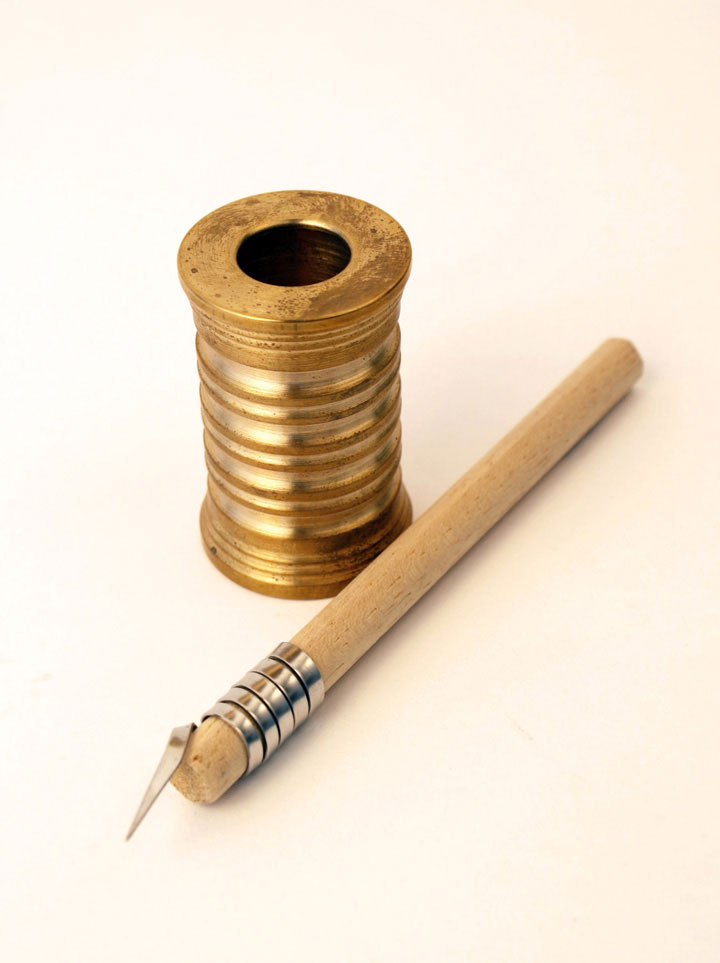Pen & Inkwell, Ancient Rome, Replica
This is a replica pen and inkpot. The pen is based on a find from Vindolanda, the site of a Roman fort and settlement along Hadrian’s Wall in northern England. The pen is made from a piece of wooden dowelling with a coiled strip of metal which coils tightly around one end and extends into a pointed nib. The pen nib would be dipped into the inkpot and the ink would be retained in the spiral groove between the metal to create a little cartridge. The brass inkpot has been cast with horizontal ridges.
The pen would be used to write on smooth wooden writing surfaces, called tablets. At Vindolanda writing tablets have been discovered that are considered to be the oldest surviving handwritten documents in Britain. The messages are written on fragments of postcard sized wooden leaf made from locally grown birch, ash and oak. The ink was made from carbon mixed with gum Arabic and water.
Like postcards from the past, the tablets allow a rare insight into the real lives of people living and working at Vindolanda nearly 2000 years ago. They provide a fascinating insight into private and military lives from a different time but are quite familiar, covering matters from birthdays through to underpants! Have we changed that much in two millennia?

Pen Length:9cm Pot Height:5cm Width:3cm

Pen Length:9cm Pot Height:5cm Width:3cm

This is a replica pen and inkpot. The pen is based on a find from Vindolanda, the site of a Roman fort and settlement along Hadrian’s Wall in northern England. The pen is made from a piece of wooden dowelling with a coiled strip of metal which coils tightly around one end and extends into a pointed nib. The pen nib would be dipped into the inkpot and the ink would be retained in the spiral groove between the metal to create a little cartridge. The brass inkpot has been cast with horizontal ridges.
The pen would be used to write on smooth wooden writing surfaces, called tablets. At Vindolanda writing tablets have been discovered that are considered to be the oldest surviving handwritten documents in Britain. The messages are written on fragments of postcard sized wooden leaf made from locally grown birch, ash and oak. The ink was made from carbon mixed with gum Arabic and water.
Like postcards from the past, the tablets allow a rare insight into the real lives of people living and working at Vindolanda nearly 2000 years ago. They provide a fascinating insight into private and military lives from a different time but are quite familiar, covering matters from birthdays through to underpants! Have we changed that much in two millennia?




















